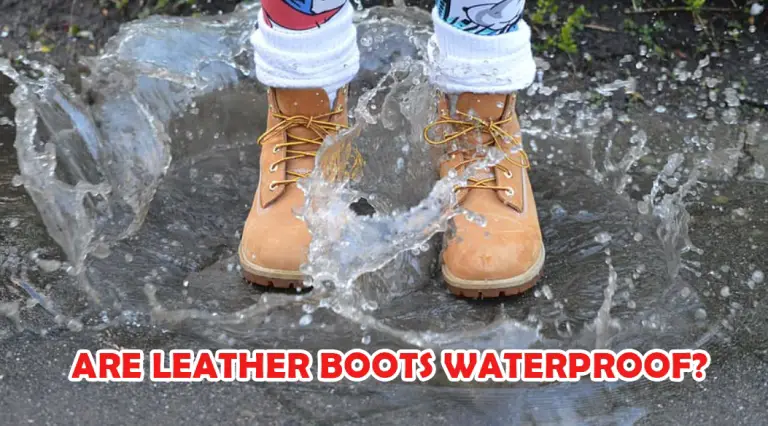Blog
Are Leather Boots Waterproof?
“Are leather boots waterproof?” is a question that will haunt new shoe enthusiasts. Although leather is known as one of the most durable and adaptable materials, the damage wetness can do isn’t something we want to risk.
Therefore, we will take a leap deeper into the world of footwear and learn more about leather boots specifically.
Contents
Waterproof vs Water Resistant vs Water Repellent
Although we see these terms more often and even use them interchangeably, they refer to different concepts. According to scientists, all three of them indicate water resistance, albeit at different levels.
Water-resistant
- Lowest level of protection
It is a basic ability when certain materials can remain dry when coming into contact with limited wetness, such as snow or soft rain. When pressure is applied, water can permeate and drench the entire shoe.
Water-repellant
- Medium level of protection
Products tagged with this term are naturally or treated to be sealed. More severe weather conditions or pressure wouldn’t be enough to get them soaked in water.
Waterproof
- The highest level of protection
The seals on these items are extremely tight regardless of the test they endure. Water will simply roll off and leave no trace behind.
Are Leather Boots Waterproof?
The short and definite answer is no. Leather has natural water resistance that we can improve with treatments, but is still a product of the skin in the end. Animal skins are porous and thus very permeable.
With enhanced water resistance and the right product for waterproofness, leather boots are good for snow, light rain, or mildly wet terrain.
If you want them to handle more, the waterproofing products will be the determining factor.
What Affects Leather’s Water Resistance?
Some leather boots seem to be much better than others, despite having the same quality levels. So what makes the difference?
Different types of Leather
Full-grain Leather
Although it is the top-quality type of leather for shoes, full-grain leather boots are not waterproof and only water-resistant, with durability as its second benefit.
To make full-grain leather waterproof and protect the expensive cuts from damage, treatments are often necessary.
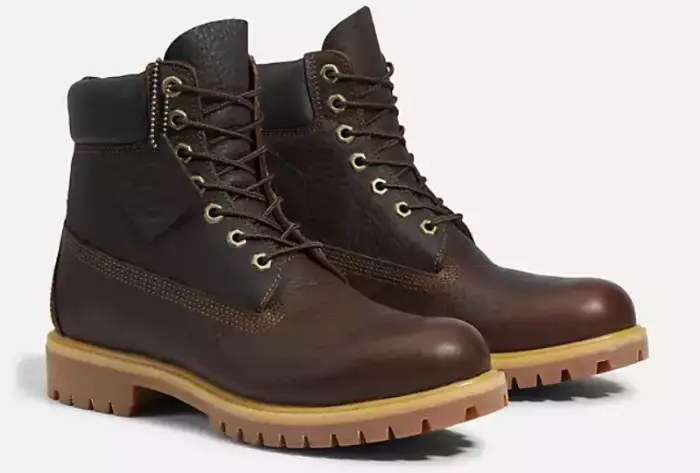
Nubuck
As full-grain leather has undergone treatment and buffing-down, nubuck has a distinctive finish that darkens if it gets some water but doesn’t get absolutely wrecked by rainwater splashing on it.
Using water-repellant or waterproof products is often highly recommended for nubuck leather.
Suede
Unlike the previous two, suede is quite sensitive and vulnerable to damage because it is on the underside of the hide, where the structure is much weaker than full-grain leather.
It also receives some softening to end up velvety and smooth.
Even if we put rainfall aside, the humidity in the air is already enough to cause discoloration on suede, so it needs treatment even more to maintain its appearance.
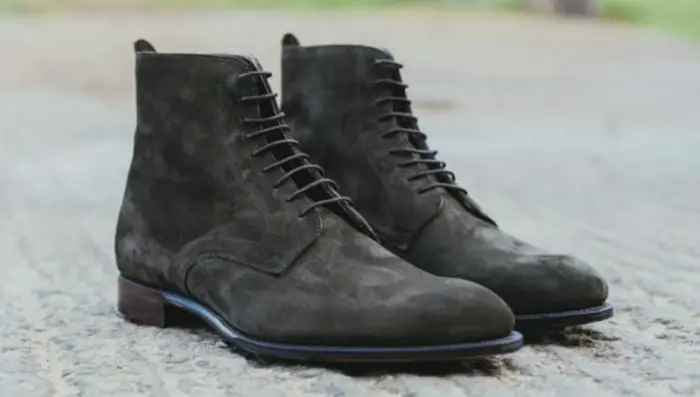
Artificial Leather
Made of synthesized fibers such as PU and PVU, faux leather isn’t porous and permeable to wetness. So, it ends up being the best choice if you want waterproof leather boots without relying on treatment products.
If you are not a fan of petroleum-based products, pineapple or cactus leathers are worthy alternatives, too.
Leather Cuts
The most common leathers in the industry are buffalo and bovine, though manufacturers can choose certain cuts they consider better for their designs.
For the long boots that reach up to your knees or thighs, the cuts will be horizontally split into multiple layers and each layer is thinner.
Manufacturers name these cuts “corrected grain”: less tough and consequently less water-resistant.
On the other hand, we have “full grain” leather with its full thickness. Because it is not sanded or split, it is stronger than “corrected grain” and is also classified as a premium-quality cut.
Leather Treatments
Each manufacturer handles their leather cuts differently, and the treatments will change the performance quite remarkably.
A good example is the crazy horse leather with the specialized wax coating that gives off a vintage vibe and enhances all properties, including water resistance.
The V-Dri membrane is a rather well-known technology that creates a barrier against wetness for your feet without taking away any breathability.
What To Do When Your Leather Boots Get Wet?
When soaked in wetness beyond what it can endure, leather will endure a few negative effects.
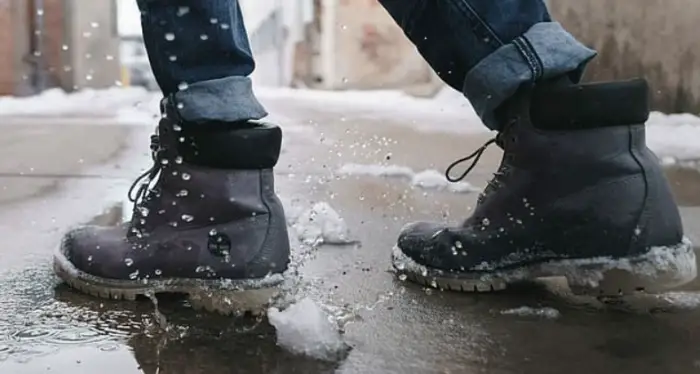
The leather becomes stiff, brittle, and heavy
The usual softness we are so familiar with comes from the bond between the components in leather and the moisturizer molecules, which is why we need to condition leather with oil products.
When water permeates the texture of leather, it takes the oil away and evaporates into thin air, leaving the leather dry and prone to cracks.
Leather might develop a stale odor
If you leave a leather product in the most damp and grim corner of your house, mold, and mildew will take the opportunity to grow and ruin the pleasant smell of leather.
If you get water splashing on your boots, the consequences might not be as bad, though when water vaporizes, only the dirt is left, and we don’t want such unattractive stains on our favorite footwear.
If you have this unfortunate situation, the first thing to do is use a soft cloth to remove the excess wetness and give your boots some time to dry.
While the leather is slightly damp, apply an oil conditioner with a soft brush so the lost oil molecules are replenished.
Avoid using direct heat sources to handle your drenched boots at all costs, because it will only worsen the lack of moisture you are facing.
Some Products For Waterproofing Leather Boots
The most effective and doable method to make your leather boots waterproof is to use specialized products.
No matter which product you choose, the basic process involves removing the laces and the accessories (if there are any) and wiping the dirt off with a soft brush or cloth.
Stains can make the coating uneven and thus not pleasant for the eyes.
Oil
Oil is the most common product for waterproofing boots because it is a great moisturizer for the texture of the leather. It also acts as a layer of protection so dirt and debris can’t get to the leather and stick to it.
A soft cloth and a sufficient amount of oil are all you need for the task. If you use too much oil, the leather fibers might become overly saturated and split.
Since oil can evaporate over time and water can also wash it off, you will need to apply more oil after 4 – 6 weeks or every time the boots get wet.
Spray
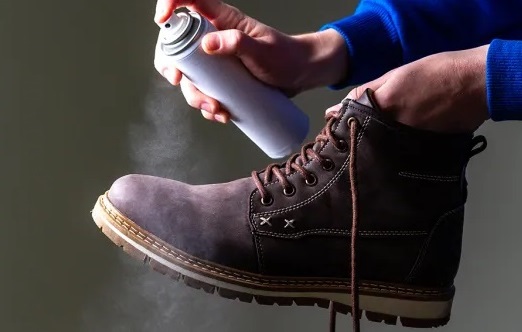
Waterproof sprays are certainly one of the most convenient products for our task. People also favor sprays because they are good for various synthetic materials and not just leather.
When spraying, you should keep a distance of 8 – 12 inches between the nozzle & the boots and maintain a steady, thin coating all over the leather surface. Once the footwear dries, you can enjoy its comfort right away.
Spray and oil are quite the same because they both require you to re-apply regularly or when the shoes are wet.
Cream
Originating from the wool oil of sheep, lanolin cream is another natural product to enhance the waterproofness of leather.
Before innovative alternatives were invented, the cream had been in use for centuries. Even now, it is still relevant in footwear maintenance, despite not being compatible with synthetic materials.
Lanolin is more on the liquid side when heated, and solid if cold. Soft fabric or your fingers will suffice to spread the cream all over the boots.
Paste
A lot of people don’t enjoy the liquid forms of oil and spray, hence paste is another amazing choice for waterproofing products.
Rather than brushes, you will need a soft and clean cloth to apply waterproof paste. Use back-and-forth motions to spread the substance evenly without letting it accumulate in certain spots.
Wax
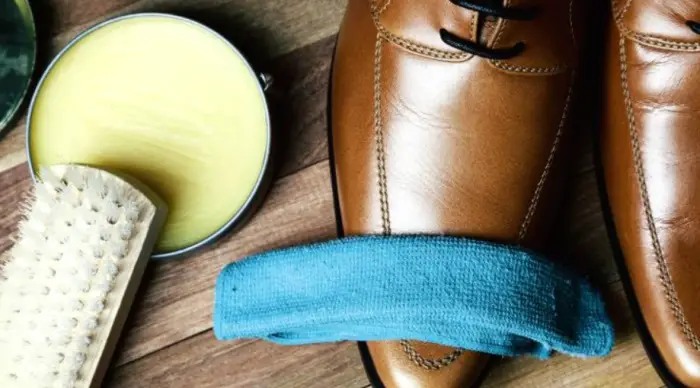
With strong waterproofing properties, wax is yet another reliable product you can try, especially beeswax. Due to their natural origins, waxes don’t have any negative effects on leather.
As wax comes in a solid form, you will need to use heat to make it more pliable to work with. Your hands will be your tools here, so no crevices and cracks linger on once you are done.
Seam Sealant
Rather than the surface of your boots, seam sealants will target the seams and the stitches so wetness cannot permeate these vulnerable spots and get inside your shoes.
In the beginning, seam sealants seemed like an optional method, yet moisture accumulation at the seams might tear the sole of your boot off.
Final Words
Learning how leather boots are waterproof and what you can do to keep your favorite shoes safe from external damage is a crucial process to preserve their longevity and ensure you won’t have any of your days ruined by the nuisance named wet feet.
Figure out what your boots are made of, choose the right product, and you are ready to give them an upgrade!

